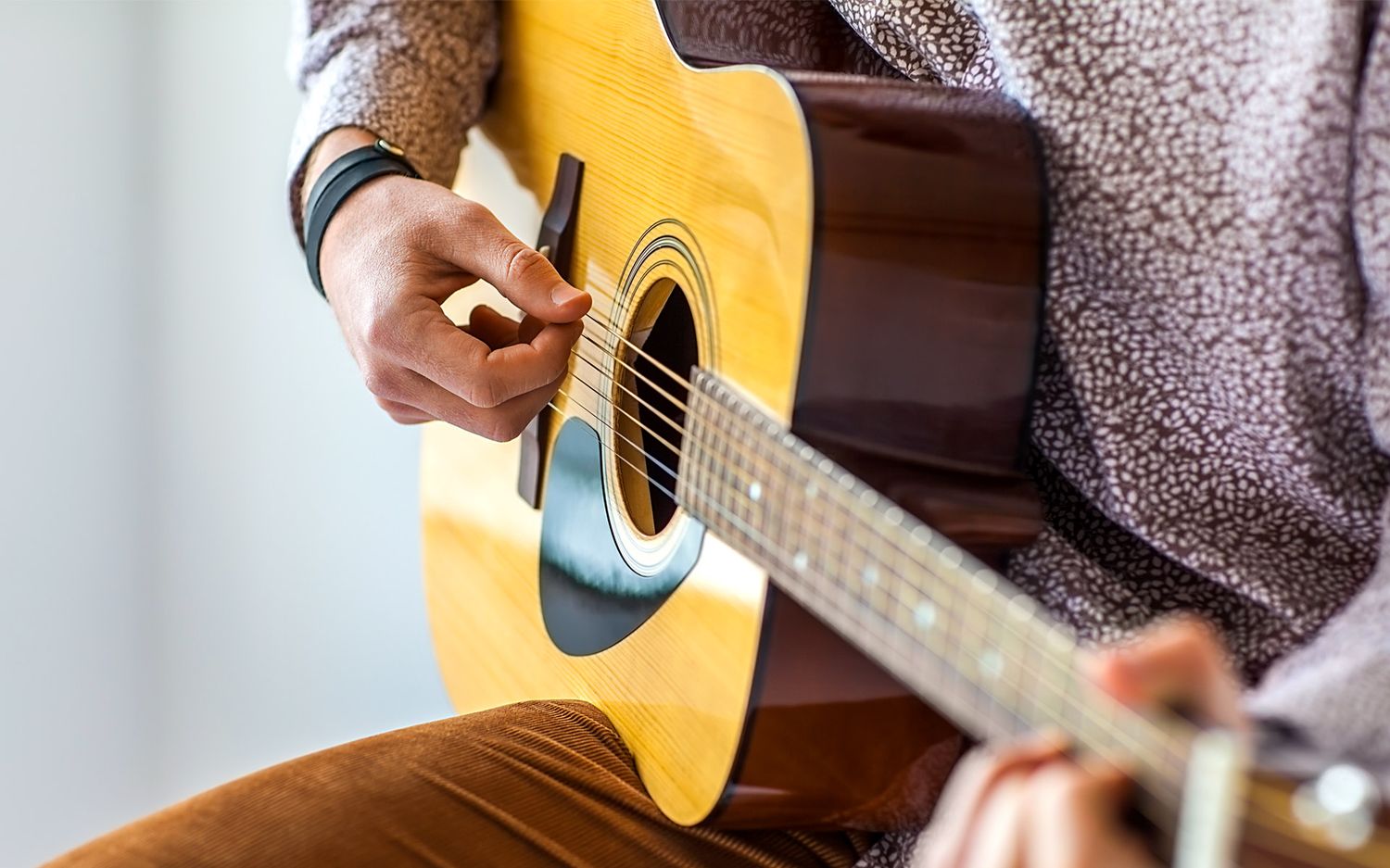Home>Instruments>Guitar>How To Learn Guitar For Free


Guitar
How To Learn Guitar For Free
Modified: February 15, 2024
Learn to play guitar for free with our comprehensive online tutorials. Master chords, scales, and techniques to become a skilled guitarist. Start your musical journey today!
(Many of the links in this article redirect to a specific reviewed product. Your purchase of these products through affiliate links helps to generate commission for AudioLover.com, at no extra cost. Learn more)
Table of Contents
Introduction
So, you've decided to learn how to play the guitar, but you're not sure where to start. The good news is that there are numerous resources available for free that can help you kick off your guitar journey without breaking the bank. Whether you're a complete beginner or someone who has dabbled in guitar playing before, this guide will walk you through the process of learning the guitar for free.
Learning to play the guitar can be an incredibly rewarding experience. Not only does it allow you to express yourself through music, but it also offers a sense of accomplishment as you see yourself improving over time. Plus, with the wealth of free resources available online, there's never been a better time to start learning how to play this versatile instrument.
In this guide, we'll explore the various avenues you can take to access free guitar learning resources. From online tutorials and video lessons to interactive apps and community forums, there's no shortage of options to choose from. We'll also delve into the basics of guitar playing, including understanding the instrument, learning chords, mastering strumming techniques, and even playing your favorite songs.
Whether you're aiming to strum along to your favorite tunes around the campfire or aspire to become a proficient guitarist, this guide will equip you with the fundamental knowledge and skills needed to get started on your guitar journey. So, grab your guitar (or air guitar, if you don't have one yet), and let's dive into the world of free guitar learning!
Finding Free Resources
When it comes to learning the guitar for free, the internet is your best friend. There is a plethora of websites, apps, and online communities dedicated to helping aspiring guitarists hone their skills without spending a dime. Here are some of the top avenues for finding free guitar learning resources:
- YouTube: This video-sharing platform is a goldmine for aspiring guitarists. You can find a wide range of tutorials, lessons, and covers that cater to different skill levels and musical genres. Many professional guitarists and educators share valuable tips and techniques for free on YouTube.
- Websites and Blogs: Numerous websites and blogs offer free guitar lessons, chord charts, and music theory resources. Whether you’re looking to learn fingerstyle, blues, rock, or classical guitar, there are dedicated sites that provide comprehensive learning materials at no cost.
- Mobile Apps: There are several mobile apps available for both iOS and Android devices that offer free guitar lessons, tuning tools, and chord libraries. These apps often feature interactive learning experiences and are perfect for practicing on the go.
- Community Forums: Engaging with online guitar communities can be invaluable for beginners. Forums and discussion boards provide a platform to ask questions, seek advice, and connect with fellow guitar enthusiasts. Many experienced players are generous with their knowledge and are willing to offer guidance for free.
- Library Resources: Don’t overlook your local library as a source of free guitar learning materials. You can borrow instructional books, DVDs, and sheet music to supplement your online learning.
By leveraging these free resources, you can create a diverse and personalized learning experience that suits your individual learning style and musical preferences. Whether you prefer visual lessons, interactive apps, or written guides, there’s something for everyone in the world of free guitar learning resources.
Basics of Guitar
Before diving into playing the guitar, it’s essential to familiarize yourself with the instrument itself. The guitar consists of several main parts, including the body, neck, fretboard, headstock, tuners, and strings. Understanding the anatomy of the guitar will help you feel more comfortable and confident as you begin your learning journey.
One of the first concepts to grasp is how to hold the guitar properly. Whether you’re playing an acoustic or electric guitar, maintaining the correct posture and hand positioning is crucial. This ensures that you can play comfortably and avoid unnecessary strain on your body.
Next, it’s important to learn about tuning. Standard tuning for a six-string guitar is EADGBE, from the lowest-pitched string to the highest. Tuning your guitar ensures that it produces the correct notes and sounds in harmony with other instruments.
Understanding basic music theory is also beneficial. Learning about notes, scales, and the layout of the fretboard will provide a solid foundation for your guitar journey. Additionally, familiarizing yourself with common guitar techniques such as fingerpicking, strumming, and fretting will set the stage for more advanced playing in the future.
As you acquaint yourself with the basics, take the time to explore the different types of guitars available. Acoustic, electric, classical, and bass guitars each have their unique characteristics and playing styles. By understanding the distinctions between these instruments, you can make an informed decision about which type of guitar best suits your musical aspirations.
Lastly, don’t underestimate the power of practice. Developing muscle memory and finger dexterity takes time and dedication. Regular practice sessions, even if they’re brief, can yield significant improvements in your playing ability over time.
By mastering the basics of the guitar, you’ll build a strong foundation for your musical journey and set the stage for more advanced learning as you progress. Embrace the learning process, stay patient, and enjoy every step of your guitar-playing adventure.
Learning Chords
Chords are the building blocks of music, and mastering them is essential for any aspiring guitarist. A chord is a combination of three or more notes played simultaneously, creating harmony and shaping the tonal character of a song. Learning a variety of chords will enable you to play countless songs across different genres.
Begin with basic open chords such as C, G, D, E, and A. These chords are commonly used in numerous songs and provide an excellent starting point for beginners. Practice transitioning between these chords smoothly and accurately, as this skill forms the basis of rhythm guitar playing.
As you progress, delve into barre chords, which involve using a single finger to fret multiple strings across the guitar neck. Barre chords are movable shapes, meaning you can play them in different positions to produce various chord qualities. While barre chords can be challenging at first, mastering them will significantly expand your chord vocabulary and versatility.
Furthermore, learning chord inversions and voicings can add depth and richness to your playing. Experiment with different fingerings and positions to discover alternative ways of playing the same chord. This exploration will enhance your understanding of the fretboard and enable you to create more nuanced and expressive musical arrangements.
It’s important to practice chord changes within the context of actual songs. Choose songs with chord progressions that incorporate the chords you’re learning. This practical application will reinforce your muscle memory and help you internalize the chord shapes more effectively.
While learning chords, pay attention to your fretting hand’s positioning and finger placement. Developing proper technique early on will prevent bad habits and facilitate smoother chord transitions as you tackle more complex music in the future.
Remember, learning chords is an ongoing process. Even experienced guitarists continually explore new chord voicings and variations to expand their harmonic palette. Embrace the journey of discovering and mastering chords, and you’ll unlock a world of musical possibilities on the guitar.
Strumming Techniques
Mastering strumming techniques is fundamental to becoming a proficient guitarist. Strumming provides the rhythmic foundation and dynamic expression essential for accompanying songs and creating engaging performances. Here are some key strumming techniques to focus on as you progress in your guitar journey:
- Downstrokes and Upstrokes: Begin by practicing basic downstrokes and upstrokes. Downstrokes involve strumming the strings in a downward motion, typically on the strong beats of a measure, while upstrokes involve strumming upward, often on the weaker beats. Practice maintaining a steady rhythm and consistent strumming motion.
- Strumming Patterns: Explore various strumming patterns to add rhythmic diversity to your playing. Common patterns include the popular down-down-up-up-down-up pattern and its numerous variations. Experiment with different patterns to find ones that complement the mood and tempo of the songs you’re playing.
- Dynamic Control: Focus on controlling the dynamics of your strumming. This involves varying the intensity and volume of your strumming to convey emotion and musical expression. Learning to strum softly for gentle passages and strumming with vigor for powerful sections enhances the musicality of your playing.
- Percussive Strumming: Incorporate percussive elements into your strumming by muting the strings with your fretting hand while strumming. This technique adds rhythmic accents and percussive flair to your playing, especially in genres like funk, pop, and percussive acoustic styles.
As you practice strumming, pay attention to your strumming hand’s position and wrist movement. Maintaining a relaxed and fluid wrist motion is crucial for developing a natural and effortless strumming technique. Additionally, be mindful of the angle of your pick and the amount of contact it makes with the strings to achieve the desired tone and articulation.
Listening to professional recordings and live performances can provide valuable insight into how different strumming techniques are applied in real-world musical contexts. Observing and emulating the strumming styles of accomplished guitarists can inspire new ideas and approaches to enhance your own playing.
Ultimately, honing your strumming techniques requires consistent practice and attentive listening. Embrace the rhythmic intricacies of strumming, and you’ll develop the skills to enliven your guitar playing with dynamic and expressive strumming patterns.
Playing Songs
Playing songs is the culmination of your guitar learning journey, allowing you to apply the skills and techniques you’ve acquired in a musical context. Whether you aspire to strum along to your favorite tunes or perform intricate fingerstyle arrangements, learning songs is a gratifying and essential aspect of mastering the guitar.
When selecting songs to learn, consider starting with those that feature simple chord progressions and strumming patterns. This approach enables you to build confidence and familiarity with transitioning between chords while maintaining a steady rhythm. As you gain proficiency, gradually introduce songs with more complex chord structures and rhythmic variations to expand your musical repertoire.
Listening actively to the songs you wish to learn is crucial. Pay attention to the song’s structure, dynamics, and nuances. By familiarizing yourself with the original recordings, you’ll develop a deeper understanding of the song’s arrangement and be better equipped to replicate its feel and character on the guitar.
Utilize online resources such as chord charts, tabs, and video tutorials to aid your learning process. Many websites and apps offer free access to a vast library of song transcriptions, making it convenient to learn songs at your own pace. Additionally, watching live performances and cover versions of songs can provide valuable insight into different interpretations and approaches to playing them.
As you tackle songs, focus on playing along to recordings to develop your sense of timing and musical phrasing. This immersive experience will help you internalize the song’s structure and groove, fostering a deeper connection with the music as you play. Don’t be discouraged by mistakes; they are an integral part of the learning process and serve as opportunities for improvement.
Furthermore, consider exploring songwriting and composition as a natural progression in your guitar journey. Experimenting with crafting your own melodies, chord progressions, and lyrics can deepen your musical creativity and offer a unique outlet for self-expression through the guitar.
Ultimately, playing songs is a joyful and fulfilling endeavor that allows you to share the universal language of music. Embrace the process of learning and mastering songs, and you’ll discover the profound satisfaction of bringing music to life through your guitar playing.
Improving Technique
Continuous improvement of your guitar technique is essential for evolving as a musician and unlocking new possibilities in your playing. Whether you’re a beginner or have been playing for some time, refining your technique can elevate your musical expression and pave the way for tackling more advanced musical challenges.
One crucial aspect of technique improvement is maintaining proper posture and hand positioning. Ensuring that your fretting hand and strumming hand are ergonomically positioned minimizes the risk of strain and injury while promoting efficient and fluid movement across the fretboard and strings.
Focus on developing finger strength and dexterity through targeted exercises and practice routines. Regularly practicing scales, arpeggios, and technical exercises can enhance your finger independence and agility, enabling you to navigate the fretboard with precision and control.
Additionally, pay attention to your picking technique. Whether you use a pick, fingerstyle, or a combination of both, refining your picking accuracy and control is crucial for articulating notes and phrases with clarity and expressiveness. Practice exercises that emphasize alternate picking, string skipping, and string damping to sharpen your picking skills.
Ear training is an invaluable tool for improving your musicality and technique. Developing a keen ear for pitch, rhythm, and tonal nuances allows you to learn songs by ear, improvise freely, and adapt to various musical styles with greater ease. Engage in activities such as transcribing melodies and solos, as well as playing along with backing tracks to enhance your ear’s musical sensitivity.
Exploring different musical genres and playing styles can broaden your musical horizons and enhance your technical versatility. Whether it’s delving into jazz, blues, classical, or flamenco guitar, each genre offers unique challenges that can enrich your playing and expand your technical prowess.
Seeking feedback and guidance from experienced guitarists or music instructors can provide valuable insights into areas for improvement and offer personalized advice for refining your technique. Embracing a mindset of continual growth and learning is key to advancing your guitar skills and honing your technique over time.
Remember, improvement is a gradual process that requires patience, dedication, and consistent practice. Embrace the journey of refining your technique, and you’ll find that each incremental advancement brings you closer to realizing your full potential as a guitarist.
Conclusion
Congratulations on embarking on your journey to learn the guitar for free! As you’ve discovered, the wealth of resources available, from online tutorials and chord libraries to interactive apps and community forums, has made it more accessible than ever to pursue your passion for music without financial barriers.
By familiarizing yourself with the basics of the guitar, including its anatomy, tuning, and foundational techniques, you’ve laid a solid groundwork for your musical exploration. Learning chords and strumming techniques has equipped you with the essential tools to start playing songs and expressing yourself through music.
As you progress on your guitar journey, remember that improvement is a continuous process. Embrace the opportunity to refine your technique, expand your repertoire, and explore new musical horizons. Whether you aspire to strum along to your favorite songs, master intricate fingerstyle arrangements, or even compose your own music, the guitar offers a world of creative possibilities.
While the path to guitar mastery may present challenges, it’s important to approach your learning with patience, perseverance, and a sense of joy and curiosity. Every chord learned, strum perfected, and song mastered is a testament to your dedication and passion for music.
Finally, remember that learning the guitar is not just about acquiring technical skills; it’s about expressing yourself, connecting with others through music, and finding inspiration in the melodies and rhythms that resonate with you. Whether you’re playing for your own enjoyment or sharing your music with others, the guitar has the power to enrich your life in profound ways.
So, pick up your guitar, immerse yourself in the world of free resources, and let the music guide you on an enriching and fulfilling journey. As you continue to learn, practice, and play, may the joy of music be your constant companion, and may your guitar become a faithful companion in your creative endeavors.











